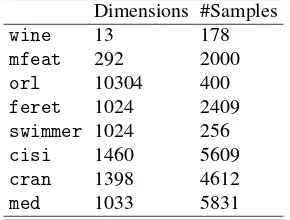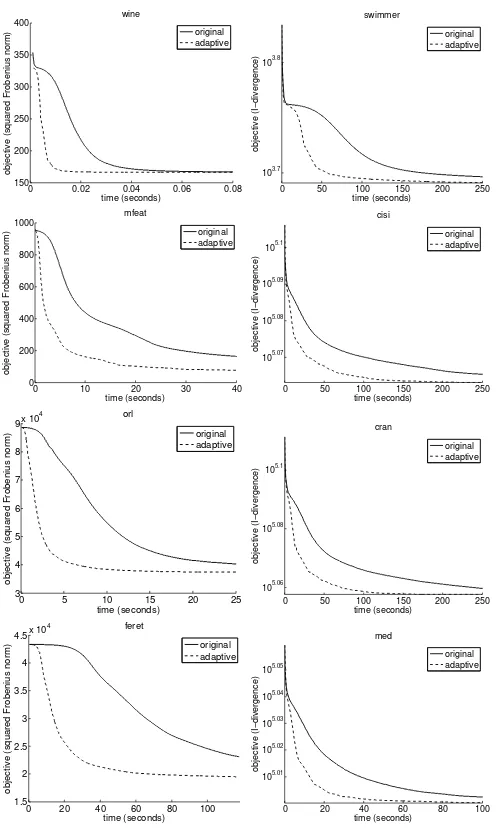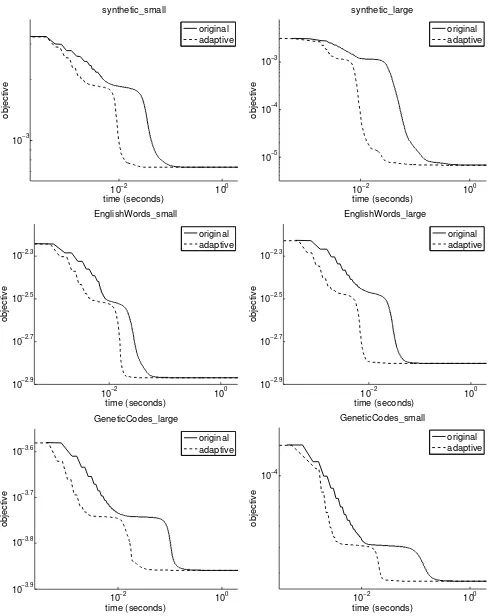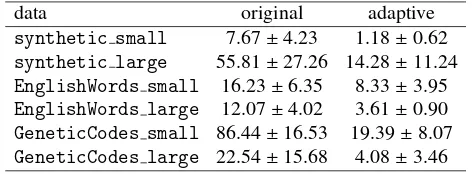Adaptive multiplicative updates for quadratic nonnegative matrix factorization
He Zhang∗, Zhirong Yang, Erkki Oja
Department of Information and Computer Science, Aalto University, Espoo, Finland
Abstract
In Nonnegative Matrix Factorization (NMF), a nonnegative matrix is approximated by a product of lower-rank factorizing matrices. Quadratic Nonnegative Matrix Factorization (QNMF) is a new class of NMF methods where some factorizing matrices occur twice in the approximation. QNMF finds its applications in graph partition, bi-clustering, graph matching, etc. However, the original QNMF algorithms employ constant multiplicative update rules and thus have mediocre convergence speed. Here we propose an adaptive multiplicative algorithm for QNMF which is not only theoretically convergent but also significantly faster than the original implementation. An adaptive exponent scheme has been adopted for our method instead of the old constant ones, which enables larger learning steps for improved efficiency. The proposed method is general and thus can be applied to QNMF with a variety of factorization forms and with the most commonly used approximation error measures. We have performed extensive experiments, where the results demonstrate that the new method is effective in various QNMF applications on both synthetic and real-world datasets.
Keywords:
Adaptive, Multiplicative updates, Quadratic, Nonnegative Matrix Factorization
1. Introduction
Nonnegative Matrix Factorization (NMF) has attracted a lot of research effort in recent years (e.g. [1, 2, 3, 4, 5, 6]). NMF has a variety of applications e.g. in machine learning, signal processing, pattern recognition, data mining, and information retrieval. (e.g. [7, 8, 9, 10, 11]). Given an input data matrix, NMF finds an approximation that is factorized into a product of lower-rank matrices, some of which are constrained to be nonnegative. The approximation error can be measured by a variety of divergences between the input and its approximation (e.g. [12, 13, 14, 6]), and the factorization can take a number of different forms (e.g. [15, 16, 17]).
In most existing NMF methods, the approximation is linear with respect to each factorizing matrix; that is, these matrices appear only once in the approximation. However, such a lin-earity assumption does not hold in some important real-world problems. A typical example is graph matching, when it is pre-sented as a matrix factorizing problem, as pointed out by Ding et al. [18]. If two graphs are represented by their adjacency matrices A and B, then they are isomorphic if and only if a permutation matrix Pcan be found such thatA−PBPT = 0. Minimizing the norm or some other suitable error measure of the left-hand side with respect toP, with suitable constraints, reduces the problem to an NMF problem. Note that both adjan-cency matrices and permutation matrices are nonnegative, and the approximation is now quadratic inP.
∗Corresponding author.
Email addresses:he.zhang@aalto.fi(He Zhang),
zhirong.yang@aalto.fi(Zhirong Yang),erkki.oja@aalto.fi(Erkki Oja)
Another example is clustering: if X is a matrix whose n
columns need to be clustered into rclusters, then the classi-cal K-means objective function can be written as [19] J1 =
Tr(XTX)−Tr(UTXTXU) whereUis the (n×r) binary cluster indicator matrix. It was shown in [20] that minimizingJ2 =
XT−WWTXT2Frobeniuswith respect to an orthogonal and non-negative matrixWgives the same solution, except for the binary constraint. This is another NMF problem where the approxima-tion is quadratic inW.
Methods for attacking this kind of problems are called Quadratic Nonnegative Matrix Factorization (QNMF). A systematic study on QNMF was given by Yang and Oja [21], where they pre-sented a unified development method for multiplicative QNMF optimization algorithms.
The original QNMF multiplicative update rules have a fixed form, where an exponent in the multiplying factor in these rules remains the same in all iterations. Despite its simplicity, the constant exponent corresponds to overly conservative learning steps and thus often leads to mediocre convergence speed.
QNMF problems. In addition to Projective Nonnegative Matrix Factorization, we also apply the strategy on two other special cases of QNMF, with corresponding application scenarios in bi-clustering and estimation of hidden Markov chains. Extensive empirical results on both synthetic and real-world data justify the efficiency advantage by using our method.
In the following, Section 2 recapitulates the essence of the QNMF objectives and their previous optimization methods. Sec-tion 3 presents the fast QNMF algorithm by using adaptive ex-ponents. In Section 4, we provide empirical comparison be-tween the new algorithm and the original implementation on three applications of QNMF. Section 5 concludes the paper.
2. Quadratic Nonnegative Matrix Factorization
Nonnegative Matrix Factorization(NMF) finds an approxi-mationbXto an input data matrixX∈Rm×n:
X≈Xb=
Q Y
q=1
F(q). (1)
and some of these matrices are constrained to be nonnegative. The dimensions of the factorizing matrices F(1), . . . ,F(Q) are
m×r1,r1×r2, . . . ,rQ−1×n, respectively. Usuallyr1, . . . ,rQ−1
are smaller thanmorn.
In most conventional NMF approaches, the factorizing ma-trices F(q)
in Eq. (1) are all different, and thus the approxima-tionXbas a function of them islinear. However, there are useful cases where some matrices appear more than once in the ap-proximation. In this paper we consider the case that some of them may occur twice, or formally, F(s) = F(t)T for a number of non-overlapping pairs{s,t}and 1 ≤ s < t ≤ Q. We call such a problem and its solutionQuadratic Nonnegative Matrix Factorization(QNMF) becausebXas a function is quadratic to each twice appearing factorizing matrix1.
When there is only one doubly occurring matrixW in the QNMF objective, the general approximating factorization form is given by [21]
b
X=AW BWTC, (2)
where the products of the other, linearly appearing factorizing matrices are merged into single symbols. QNMF focuses on the optimization overW, while learning the matrices that occur only once can be solved by using the conventional NMF meth-ods of alternative optimization over each matrix separately [11]. As stated by the authors in [21], The factorization form uni-fies many previously suggested QNMF objectives. For exam-ple, it becomes the Projective Nonnegative Matrix Factoriza-tion(PNMF) whenA=B=IandC=X[23, 24, 25, 20, 17]. If X is a square matrix andA = C = I, the factorization can be used in two major scenarios if the learnedW is highly or-thogonal: (1) WhenBis much smaller thanX, the three-factor
1Though equality without matrix transpose, namelyF(s)
=F(t), is also pos-sible, to our knowledge there are no corresponding real-world applications.
approximation corresponds to a blockwise representation ofX
[26, 27]. IfBis diagonal, then the representation becomes di-agonal blockwise, or a partition. In the extreme case B = I, the factorization reduces to theSymmetric Nonnegative Matrix Factorization(SNMF)bX=WWT [16]. (2) WhenXandBare of the same size, the learnedW with the constraintWTW = I approximates a permutation matrix and thus QNMF can be used for learning order of relational data, for example, graph match-ing [18]. Alternatively, under the constraint thatWhas column-wise unitary sums, the solution of such a QNMF problem pro-vides parameter estimation of hidden Markov chains (See Sec-tion 4.3).
The factorization form in Eq. (2) can be recursively ap-plied to the cases where there are more than one factorizing matrices appearing quadratically in the approximation. For ex-ample, the caseA = CT = U yields bX = UW BWTUT, and
A=B=I, C=XUUT yieldsbX=WWTXUUT. An applica-tion of the latter example is shown in Secapplica-tion 4.2, where the so-lution of such a QNMF problem can be used to group the rows and columns of X simultaneously. This is particularly useful for the biclustering or coclustering problem. These factorizing forms can be further generalized to any number of factorizing matrices. In such cases we employ alternative optimization over each doubly occurring matrix.
It is important to notice that quadratic NMF problems are not special cases of linear NMF [21]. In linear NMF, the factor-izing matrices are different variables and the approximation er-ror can alternatively be minimized over one of them while keep-ing the others constant. In contrast, the optimization of QNMF is harder because matrices in two places vary simultaneously, which leads to higher-order objectives. For example, given the squared Frobenius norm (Euclidean distance) as approxi-mation error measure, the objective of linear NMFkX−W Hk2
F is quadratic with respect toW andH, whereas the PNMF ob-jectivekX−WW Xk2
F is quartic with respect toW. Minimizing such a fourth-order objective with the nonnegativity constraint is considerably more challenging than minimizing a quadratic function.
3. Adaptive QNMF
The difference between the input matrixXand its approx-imationbXcan be measured by a variety of divergences. Yang and Oja [21] presented a general method for developing op-timization algorithms with multiplicative updates for QNMF based onα-divergence,β-divergence,γ-divergence or R´enyi di-vergence. These families include the most popular used NMF objectives, for example, the squared Euclidean distance (β =
1), Hellinger distance (α = 0.5), χ2-divergence (α = 2), I-divergence (α → 1 orβ → 0), dual I-divergence (α → 0), Itakura-Saito divergence (β → −1) and Kullback-Leibler di-vergence (γ → 0 orr → 1). Multiplicative update rules can be developed for more QNMF objectives, for example the ad-ditive hybrids of the above divergences, as well as many other unnamed Csisz´ar divergences and Bregman divergences.
Table 1: Notations in the multiplicative update rules of QNMF examples, where rule for QNMF X ≈ W BWT based on the squared Euclidean distance (β→1) reads
Such multiplicative learning rules have the essential advan-tage that matrixW always stays nonnegative. Note especially the role of the exponent ηin the algorithms. The value given in the Table guarantees that the objective function will be non-increasing in the iteration, and hence it will converge to a local minimum. Multiplicative algorithms using an update rule with a constant exponent in all iterations are simple to implement.
However, the exponentηalso strongly affects the conver-gence speed. It may be that a constant value as given in the Ta-ble is unnecessarily small in practice. The convergence can be accelerated by using a more aggressive choice of the exponent, which adaptively changes during the iterations. A straightfor-ward strategy is to increase the exponent steadily if the new objective is smaller than the old one and otherwise shrink back to the safe choice,η. The pseudo-code for such an implemen-tation is given in Algorithm 1, whereD(X||bX),A, Bandηare defined according to the type of cost function (Euclidean dis-tance or I-divergence). We have empirically usedµ=0.1 in all related experiments in this work. Although more comprehen-sive adaptation approaches could be applied, we find that such a simple strategy can already significantly speed up the conver-gence while still maintaining the monotonicity of updates.
4. Experiments
4.1. Projective Nonnegative Matrix Factorization
We have selected eight datasets that are commonly used in machine learning for our experiments. These datasets were
Algorithm 1Multiplicative Updates with Adaptive Exponent for QNMF
untilconvergent conditions are satisfied
Table 2: Datasets used in the PNMF experiments.
Dimensions #Samples
obtained from the UCI repository2, the University of Florida
Sparse Matrix Collection3, and the LSI text corpora4, as well as
other publicly available websites. The statistics of the datasets are summarized in Table 2.
Projective Nonnegative Matrix Factorization (PNMF) is a special case of QNMF. When squared Euclidean distance is used as the error measure, PNMF solves the following opti-mization problem: constant exponent iteratively applies the following update rule [28, 21]
The fast adaptive PNMF algorithm uses variable exponents (Al-gorithm 1) instead of the constant 1/3.
Figure 1 shows the objective function evolution curves us-ing the compared methods for eight selected datasets. One can see that the dashed lines are clearly below the solid ones in the plots, which indicates that the adaptive alogorithm is signifi-cantly faster than the original implementation.
2http://archive.ics.uci.edu/ml/
3http://www.cise.ufl.edu/research/sparse/matrices/index.
html
4
0 0.02 0.04 0.06 0.08
objective (squared Frobenius norm)
wine
objective (squared Frobenius norm)
mfeat
objective (squared Frobenius norm)
orl
objective (squared Frobenius norm)
feret
Figure 1: Evolutions of objectives using the compared methods based on (left) squared Euclidean distance and (right) I-divergence.
In addition to qualitative analysis, we have also compared the benchmark on convergence time of the three methods. Table 3 summarizes the means and standard deviations of the result-ing convergence time. The convergence time is calculated at the earliest iteration where the objectiveDis sufficiently close to the minimumD∗, i.e.|D−D∗|/D∗<0.001. Each algorithm on each dataset has been repeated 100 times with different ran-dom seeds for initialization. These quantitative results confirm that the adaptive algorithm is significantly faster: it is 3 to 5 times faster than the original method.
4.2. Two-way clustering
Biclustering, coclustering, or two-way clustering is a data mining problem which requires simultaneous clustering of ma-trix rows and columns. QNMF can be applied for finding bi-clusters in which the matrix entries have similar values. A good biclustering of this kind should be able to discover a blockwise
Table 3: The mean (µ) and standard deviation (σ) of the convergence time (seconds) of PNMF using the compared algorithms.
(a) PNMF based on Euclidean distance
dataset original adaptive
wine 0.22±0.11 0.06±0.03
mfeat 68.57±1.75 19.10±0.70
orl 117.26±1.74 29.89±1.48
feret 107.58±24.43 19.97±5.60
(b) PNMF based on I-divergence
dataset original adaptive
swimmer 613.04±20.63 193.47±5.43
cisi 863.89±69.23 193.23±18.70
cran 809.61±62.64 189.41±18.50
med 566.99±64.44 132.67±13.86
structure in the input matrix when the rows and columns are ordered by their bicluster indices.
Two-way clustering has previously been addressed by the linear NMF methods such as three-factor NMF (e.g. [16]). How-ever, this method is often stuck in trivial local minima where the middle factorizing matrix tends to be smooth or even uniform because of the sparsity of the left and right factorizing matrices [15]. An extra constraint on the middle is therefore needed.
The biclustering problem can be formulated by a QNMF problem:X ≈LLTXRRT [21]. The resulting two-sided QNMF objectives can be optimized by alternating the one-sided algo-rithms, that is, interleaving optimizations ofX ≈LLTY(R)
with
Y(R) =XRRT fixed andX ≈Y(L)RRT withY(L) = LLTXfixed. The bicluster indices of rows and columns are given by taking the maximum of each row inL andR. This method is called
Biclustering QNMF(Bi-QNMF) orTwo-way QNMF[21]. Bi-QNMF was implemented by interleaving multiplicative updates between LandRusing constant exponents. Here we compare the previous implementation with the adaptive algo-rithm with variable exponents, using both synthetic and real-world data.
Firstly, a 200×200 blockwise nonnegative matrix is gener-ated, where each block has dimensions 20, 30, 60 or 90. The matrix entries in a block are randomly drawn from the same Poisson distribution whose mean is chosen from 1, 2, 4, or 7. Next, we compared the four methods on the real-worldwebkb
dataset5. The data matrix contains a subset of the whole dataset, with two classes of 1433 documents and 933 terms. Thei j-th entry of the matrix is the number of the j-th term that appears in thei-th document.
The resulting objective evolutions over time are shown in Figure 2. We can see that the dashed curves are below the solid ones for both datasets, which indicates that the adaptive algo-rithm brings efficiency improvement. The advantage is further quantified in Table 4, where we ran each algorithm ten times and recorded their mean and standard deviation of the conver-gence times.
0 0.5 1 1.5
Figure 2: Evolutions of objectives of Bi-QNMF using the original implementa-tion and adaptive multiplicative updates: (left) synthetic data and (right)webkb data.
Table 4: The mean (µ) and standard deviation (σ) of the converged time (sec-onds) of Bi-QNMF using the compared algorithms.
data original adaptive
synthetic 17.96±0.26 5.63±0.10
webkb 139.35±76.81 25.93±13.61
4.3. Estimating hidden Markov chains
In a stationary Hidden Markov Chain Model(HMM), the observed output and the hidden state at timet are denoted by
x(t) ∈ {1, . . . ,n}andy(t) ∈ {1, . . . ,r}, respectively. The joint probabilities of a consecutive pair are then given byXi j,P(x(t)=
i,x(t+1) = j) and Ykl , P(y(t) = k,y(t+1) = l) accord-ingly. For the noiseless model, we have X = WYWT with
W , P(x(t) = i|y(t) = k). When noise is considered, this becomes an approximative QNMF problemX ≈WYWT. Par-ticularly, when the approximation error is measured by squared Euclidean distance, the parameter estimation problem of HMM can be formulated as (QNMF-HMM)
minimize
The QNMF multiplicative update rule for the above con-strained problem is
Here we apply our adaptive algorithm to relax the constant exponent in Eq. 9. We have compared the new algorithm with the original one on six datasets: the first two are synthetic se-quences generated by using the procedure by Lakshminarayanan and Raich [29], with 1000 and 10000 samples respectively; the third and fourth ar letter sequences in the top 1510 and 58112
www/data/
Figure 3: Evolutions of objectives of QNMF-HMM using the original imple-mentation and adaptive multiplicative updates: (left column) datasets with less samples and (right column) with more samples; (top) synthetic data, (middle) English words, and (bottom) genetic codes.
English words6; the fifth and sixth are genetic code sequences
of homo sapiens7, respective with lengths 30105 and 187334.
The objective evolution curves are presented in Figure 3. We can see that, for all six datasets, the adaptive method is sig-nificantly faster than the original implementation, because the dashed lines are clearly below the solid ones. The improvement is quantified in Table 5, where we ran each method ten times. The results show that our new method can be 2 to 6 times faster in general.
5. Conclusions
We have proposed a simple but effective algorithm to accel-erate optimization over nonnegative matrices in quadratic ma-trix factorization problems, using adaptive multiplicative up-date rules. The acceleration is achieved by using more aggres-sive multiplicative learning steps during the iterations. When-ever the monotonicity is violated, we switch back to the safe learning step. This simple strategy has demonstrated consider-able advantages in three QNMF applications, for a variety of synthetic and real-world datasets.
Table 5: The mean (µ) and standard deviation (σ) of the converged time (sec-onds) of QNMF-HMM using the compared algorithms.
data original adaptive
synthetic small 7.67±4.23 1.18±0.62
synthetic large 55.81±27.26 14.28±11.24
EnglishWords small 16.23±6.35 8.33±3.95
EnglishWords large 12.07±4.02 3.61±0.90
GeneticCodes small 86.44±16.53 19.39±8.07
GeneticCodes large 22.54±15.68 4.08±3.46
The accelerated algorithms facilitate applications of the QNMF methods. More large-scale datasets will be tested in the future. Moreover, the proposed adaptive exponent technique is readily extended to other fixed-point algorithms that use multiplicative updates.
6. Acknowledgement
This work was financially supported by the Academy of Finland (Finnish Center of Excellence in Computational Infer-ence Research COIN, grant no 251170; Zhirong Yang addition-ally by decision number 140398).
References
[1] D. D. Lee, H. S. Seung, Learning the parts of objects by non-negative matrix factorization, Nature 401 (1999) 788–791.
[2] D. D. Lee, H. S. Seung, Algorithms for non-negative matrix factorization, Advances in Neural Information Processing Systems 13 (2001) 556–562. [3] P. O. Hoyer, Non-negative matrix factorization with sparseness
con-straints, Journal of Machine Learning Research 5 (2004) 1457–1469. [4] S. Choi, Algorithms for orthogonal nonnegative matrix factorization, in:
Proceedings of IEEE International Joint Conference on Neural Networks, 2008, pp. 1828–1832.
[5] D. Kim, S. Sra, I. S. Dhillon, Fast projection-based methods for the least squares nonnegative matrix approximation problem, Statistical Analysis and Data Mining 1 (1) (2008) 38–51.
[6] C. F´evotte, N. Bertin, J.-L. Durrieu, Nonnegative matrix factorization with the Itakura-Saito divergence: With application to music analysis, Neural Computation 21 (3) (2009) 793–830.
[7] S. Behnke, Discovering hierarchical speech features using convolutional non-negative matrix factorization, in: Proceedings of IEEE International Joint Conference on Neural Networks, Vol. 4, 2003, pp. 2758–2763. [8] H. Kim, H. Park, Sparse non-negative matrix factorizations via
alternat-ing non-negativity-constrained least squares for microarray data analysis, Bioinformatics 23 (12) (2007) 1495–1502.
[9] A. Cichocki, R. Zdunek, Multilayer nonnegative matrix factorization us-ing projected gradient approaches, International Journal of Neural Sys-tems 17 (6) (2007) 431–446.
[10] C. Ding, T. Li, W. Peng, On the equivalence between non-negative matrix factorization and probabilistic latent semantic indexing, Computational Statistics and Data Analysis 52 (8) (2008) 3913–3927.
[11] A. Cichocki, R. Zdunek, A.-H. Phan, S. Amari, Nonnegative Matrix and Tensor Factorizations: Applications to Exploratory Multi-way Data Anal-ysis, John Wiley, 2009.
[12] R. Kompass, A generalized divergence measure for nonnegative matrix factorization, Neural Computation 19 (3) (2006) 780–791.
[13] I. S. Dhillon, S. Sra, Generalized nonnegative matrix approximations with Bregman divergences, in: Advances in Neural Information Processing Systems, Vol. 18, 2006, pp. 283–290.
[14] A. Cichocki, H. Lee, Y.-D. Kim, S. Choi, Non-negative matrix factor-ization withα-divergence, Pattern Recognition Letters 29 (2008) 1433– 1440.
[15] A. Montano, J. M. Carazo, K. Kochi, D. Lehmann, R. D. Pascual-Marqui, Nonsmooth nonnegative matrix factorization (nsNMF), IEEE Transactions on Pattern Analysis and Machine Intelligence 28 (3) (2006) 403–415.
[16] C. Ding, T. Li, W. Peng, H. Park, Orthogonal nonnegative matrix t-factorizations for clustering, in: Proceedings of the 12th ACM SIGKDD international conference on Knowledge discovery and data mining, 2006, pp. 126–135.
[17] C. Ding, T. Li, M. I. Jordan, Convex and semi-nonnegative matrix factor-izations, IEEE Transactions on Pattern Analysis and Machine Intelligence 32 (1) (2010) 45–55.
[18] C. Ding, T. Li, M. I. Jordan, Nonnegative matrix factorization for com-binatorial optimization: Spectral clustering, graph matching, and clique finding, in: Proceedings of the 8th IEEE International Conference on Data Mining (ICDM), 2008, pp. 183–192.
[19] C. Ding, X. He, K-means clustering via principal component analysis, in: Proceedings of International Conference on Machine Learning (ICML), 2004, pp. 225–232.
[20] Z. Yang, E. Oja, Linear and nonlinear projective nonnegative matrix fac-torization, IEEE Transaction on Neural Networks 21 (5) (2010) 734–749. [21] Z. Yang, E. Oja, Quadratic nonnegative matrix factorization, Pattern
Recognition 45 (4) (2012) 1500–1510.
[22] H. Zhang, Z. Yang, E. Oja, Adaptive multiplicative updates for projec-tive nonnegaprojec-tive matrix factorization, in: Proceedings of the 19th Inter-national Conference Neural Information Processing (ICONIP), 2012, pp. 277–284.
[23] Z. Yuan, E. Oja, Projective nonnegative matrix factorization for image compression and feature extraction, in: Proceedings of 14th Scandinavian Conference on Image Analysis (SCIA), Joensuu, Finland, 2005, pp. 333– 342.
[24] Z. Yang, J. Laaksonen, Multiplicative updates for non-negative projec-tions, Neurocomputing 71 (1-3) (2007) 363–373.
[25] Z. Yang, Z. Yuan, J. Laaksonen, Projective non-negative matrix factoriza-tion with applicafactoriza-tions to facial image processing, Internafactoriza-tional Journal on Pattern Recognition and Artificial Intelligence 21 (8) (2007) 1353–1362. [26] B. Long, Z. Zhang, P. S. Yu, Coclustering by block value decomposition,
in: Proceedings of the eleventh ACM SIGKDD international conference on Knowledge discovery in data mining, 2005, pp. 635–640.
[27] E. M. Airoldi, D. M. Blei, S. E. Fienberg, E. P. Xing, Mixed membership stochastic blockmodels, Journal of Machine Learning Research 9 (2008) 1981–2014.
[28] Z. Yang, E. Oja, Unified development of multiplicative algorithms for linear and quadratic nonnegative matrix factorization, IEEE Transactions on Neural Networks 22 (12) (2011) 1878–1891.



